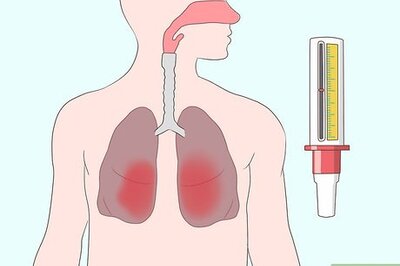
views
Wilmington: The outer bands of Hurricane Florence drenched the Carolinas on Thursday, flooding roads, gorging rivers and knocking out power in an ominous glimpse of the damage the storm could inflict when it makes landfall on Friday with millions of people in its path.
Florence, though downgraded to a Category 2 storm on the five-step Saffir-Simpson scale, remained dangerous and unpredictable, the National Hurricane Center (NHC) said.
It was forecast to make landfall mid-day Friday near Cape Fear, North Carolina, bringing up to 40 inches (1 metre) of rain, and storm surges as high as 13 feet (4 meters), the NHC said.
North Carolina Governor Roy Cooper told a news conference, that a "historic storm" would unleash rains and floods that would inundate almost the entire state.
In the North Carolina town of Wilmington, which could take a direct hit from Florence, wind gusts were stirring up frothy white caps into the Cape Fear River.
"We're a little worried about the storm surge so we came down to see what the river is doing now," said Linda Smith, 67, a retired nonprofit director. "I am frightened about what's coming. We just want prayers from everyone."
North Carolina will see up to eight months of rain in a two- to three-day period, National Weather Service forecaster Brandon Locklear said in a video briefing.
At least 88,000 people were without power in North Carolina with the brunt of the storm yet to come, according to the state's emergency management agency. Millions of people were expected to lose power from the storm and restoration could take weeks.
Roads and intersections on North Carolina's Outer Banks barrier islands were already inundated with water.
Now East of Myrtle Beach
Florence's top winds were clocked on Thursday at 100 miles per hour (170 km per hour) as it churned in the Atlantic Ocean, down from a peak of 140 mph (224 kph) earlier this week when it was classified a Category 4 storm.
The storm's centre was about 145 miles (235 km) east of Myrtle Beach, South Carolina as of Thursday night.
About 10 million people live in the path of the slow-moving storm and more than 1 million had been ordered to evacuate the coasts of the Carolinas and Virginia, jamming westbound roads and highways for miles.
At least 12,000 people had taken refuge in 126 emergency shelters, Cooper said, with more facilities being opened.
The National Hurricane Center warned the threat of tornadoes was increasing as Florence neared shore and South Carolina Governor Henry McMaster said the heavy rains could trigger landslides in the western part of his state.
NHC Director Ken Graham said on Facebook the storm surges could push in as far as 2 miles (3 km). Heavy rains were forecast to extend into the Appalachian Mountains, affecting parts of Alabama, Tennessee, Kentucky and West Virginia.
Emergency declarations were in force in Georgia, South and North Carolina, Virginia, Maryland and the District of Columbia.
Despite pleas from state and local officials, some residents rejected calls to evacuate.
Near the beach in Wilmington, a Waffle House restaurant, part of a chain with a reputation for staying open during disasters, had no plans to close, even if power is lost. It had long lines on Thursday.
In the tiny community of Sea Breeze near Wilmington, Roslyn Fleming, 56, made a video of the inlet where her granddaughter was baptized because "I just don't think a lot of this is going to be here" later.
Will Epperson, a 36-year-old golf course assistant superintendent, said he and his wife had planned to ride out the storm at their home in Hampstead, North Carolina, but reconsidered due to its ferocity. Instead, they drove 150 miles (240 km) inland to his mother's house in Durham.
"The anxiety level has dropped substantially," Epperson said. "I've never been one to leave for a storm but this one kind of had me spooked."


















Comments
0 comment